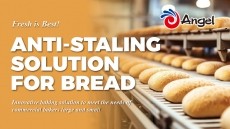Meet APRIL – the food production robot that prepares dishes like a chef

Hundreds of industry specialists were recently introduced to APRIL (Automated Processing Robotic Ingredient Loading) at an event organised by automation solutions provider OAL and the University of Lincoln at the UK's National Centre for Food Manufacturing. The session was held to demonstrate to manufacturers what can be achieved using robots to handle ingredients and cook food, so that food manufacturing can become more efficient and safer.
'Food manufacturers are at a crossroads'.
“Consumer demand for greater choice and convenience versus the rising cost of food production due to the introduction of the living wage has led food manufacturers to a crossroads,” OAL sales and marketing manager Jake Norman told BakeryandSnacks. “These interlinking factors mean the time is now for robotics and automation to deliver flexible food production at the lowest cost.”
According to Norman, other industries have embraced technology as an alternative to people to great effect. For example, Amazon changed the way its fulfillment centers operate with the adoption of robotics, having previously relied on agency labor to fulfill orders. In 2012, Amazon acquired a robotics company and has since remodeled fulfillment centers, deploying more than 30,000 Kiva robots in the process. Robots now move items around warehouses - reducing costs, footprint and improving consistency.
“Unlike other manufacturing industries, there’s been limited progress in automating much of food production due to the lack of enabling technology,” added Norman. “A key factor supporting future adoption has been the significant reduction in the cost of robotic equipment following the full-scale adoption of robotics in other manufacturing industries.
“Coupled with the cost of computing falling, automated robotic systems can now be implemented within the same budgets as traditional food processing systems.”
Global Centre of Excellence for Robotic Food Manufacturing
OAL’s vision is to create a Global Centre of Excellence for Robotic Food Manufacturing at the University of Lincoln to educate the industry, partner with early adopters and deliver change in manufacturing.
Together, they have developed APRIL, a robotic chef that allows users to scale up how food is prepared using flexible robotic cells.
APRIL offers flexibility by linking cooking and materials-handling technologies with automated ingredient loading cells that emulate professional chefs.
'Modular robotics cells may transform food manufacturing kitchens'
Simon Lushey, specialist food technical manager, Marks & Spencer
"We are excited by the thinking involved in the APRIL robotic chef approach,” said Simon Lushey, specialist food technical manager at Marks & Spencer at the launch event. “Modular robotics cells may transform food manufacturing kitchens, by breaking up processes in a different way, providing a step-change in performance. The trigger for their introduction will be the ability to improve taste, consistency, quality and value of consumer products."
OAL claims a 7% to 14% bottom line improvement could be achieved by adoption of the technology within existing chilled food plants. The business added that, in the case of chilled/ambient short-run production such as ready meals, finished products are often over-processed and costly due to the inefficiencies of traditional cooking and processing methods.
OAL identified the following as key areas where robotics could help food manufacturers:
Cost reduction
For a chilled food production business with sales of £19m ($27m), modelling by OAL suggests annual savings of 8% would be achieved through a leaner labor force, yield enhancement, asset return, smaller factory footprint and energy usage.
Flexibility
The flexibility of the systems allows soft reconfiguration to accommodate evolving consumer tastes, said Norman, who added that previously attempts at achieving automation had often missed this "key component".
In a traditional cooking system using vessels that are often one-size-fits-all, adding new devices can be expensive due to the engineering works required, says Norman. In contrast, robotic chef systems enable the use of multiple processing devices that aren’t restricted to a specific vessel, while the ability to interface with new devices means it is easy to add cooking technologies at a low cost. For instance, a device could be added to a manufacturing cell to produce more exotic products, such as a frothing device for manufacturing frothy soup.
Quality & consistency
Manufacturers will be able to improve product quality by better emulating a chef's kitchen, said Norman. In contrast with many traditional food manufacturing systems, APRIL never transfers food through pumps or pipework but instead pours product to other vessels and fillers, like a chef.
Abrasion on the pipe wall, and the pumping action itself, can damage food as particulates will disintegrate and quality is lost, according to OAL, which said using a robotic chef can maintain the integrity of even the most challenging ingredients, such as whole raspberries that break down into pieces when passed through pumps and pipework.
Food safety & traceability
Automated manufacturing cells could also provide a step-change in food safety and traceability, suggested OAL. They could removing the 'human' factor from operations and eliminate handling and procedural errors.
Automotive manufacturing underwent a paradigm shift, said Norman, and it is now the norm for robots to manufacture safer cars: "Is it time a similar paradigm shift is needed in food processing?"
Scalability
Modular, robotic systems naturally lend themselves to achieving scalability as they significantly reduce the marginal cost of manufacturing another product, unlike traditional systems that have capacity limitations. With robotic-based systems, an extra cook module can be simply added to increase capacity.
OAL said that, thanks to the success of the APRIL launch event, it plans to hold another on October 13, also at the National Centre for Food Manufacturing.














